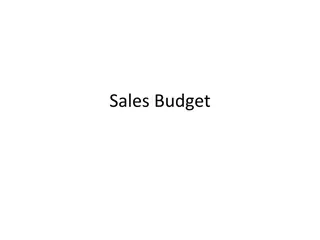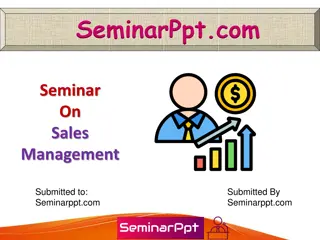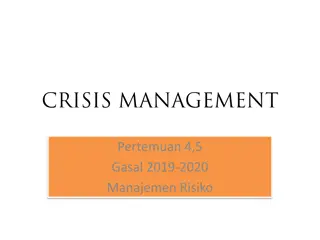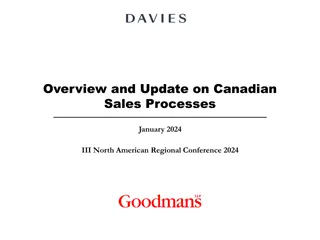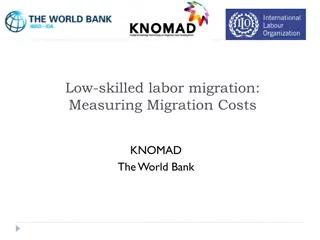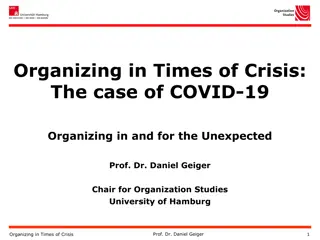Quick Measures in a Crisis: Reduce Costs, Increase Sales
Increase sales and reduce costs with quick measures during a crisis. Boost sales performance, offer extended warranties, enhance service offerings, and implement strategic pricing tactics. Explore innovative service offers, cross-selling opportunities, and procurement savings strategies to overcome challenges and drive business growth.
Download Presentation

Please find below an Image/Link to download the presentation.
The content on the website is provided AS IS for your information and personal use only. It may not be sold, licensed, or shared on other websites without obtaining consent from the author.If you encounter any issues during the download, it is possible that the publisher has removed the file from their server.
You are allowed to download the files provided on this website for personal or commercial use, subject to the condition that they are used lawfully. All files are the property of their respective owners.
The content on the website is provided AS IS for your information and personal use only. It may not be sold, licensed, or shared on other websites without obtaining consent from the author.
E N D
Presentation Transcript
Quick Measures in a Crisis: Reduce costs, increase sales
Quick Measures: Marketing and Sales Increasing Sales (and therefore Cash-Flow) has a huge impact on overcoming the crisis. Sales /Salesforce Oriented Offers / Price Oriented Customer Oriented Service Oriented Boost Sales Performance Cut Volume Offer Extended Warranties Enhance Value Chain by enhanced service offerings Increase Core selling Time Cut Prices Intelligently Arrange Trial Periods Increase service flexibility Visit Customers more Selectively Discounts in Kind not in Prices Accept Success-Dependent Payments Change from Product to systems provider Strengthen Direct Sales Price-Bundling Communicate Tangible Benefits Increase share of customers with service contracts Before you try to increase sales on bend and break through lowering prices, you need to make sure that you still earn money with your products: Start with an update on calculations to know your costs! Strengthen Cross-Selling and Up-selling Defend your Prices Accept Barter Trades Shift your Focus from Original Market to Aftermarket Penetrate new customer segments Increase prices under Customers Radar Lure customers away from weakened competitors Develop Innovative Service Offers New business models Offer special Incentives Clean out discount jungle Redeploy Staff to Sales Charge additional services Lure Salespeople away from Competitors Don t go into Price Wars Mobilize top Sales Excellence screening for business health
14 Quick Measures for Procurement Savings 1. Avoid / Reduce Maverick Spend 1. Avoid / Reduce Maverick Spend Maverick spending, also known as tail spend, or rogue spending, can account for up to 80% of purchases made in an organization that lacks a centralized purchase-to-pay procurement process. As this spend is not yet managed by procurement, it might be a quick win, provided you can navigate well end-users & convince them of the benefits. Procurement savings can be made in a number of areas within a business. The aim of procurement savings are to drive down procurement costs, improve supplier terms and decrease product prices. As you go through our methods to increase procurement savings, consider which are the easiest methods that can make a big difference to you. You can look through spend records to find any uncontrolled spending, then assign them to You can look through spend records to find any uncontrolled spending, then assign them to your preferred suppliers and go over your process with the end your preferred suppliers and go over your process with the end- -users and your team. users and your team. 2. Review Supplier s Terms & Discounts 2. Review Supplier s Terms & Discounts Ensure that a Master Agreement exists for all the suppliers. Discuss with your suppliers as to when you may make procurement savings by altering your purchasing patterns. It may be that by purchasing slightly more products you automatically receive a higher discount. 3. Consolidate Suppliers & Deliveries 3. Consolidate Suppliers & Deliveries Make savings in delivery charges and the costs of accepting those deliveries. Processing the purchasing documentation and payment processing charges will also fall. screening for business health
14 Quick Measures for Procurement Savings Depending on what stage of cost management your organization is, some will be 'quick wins' and some others will be 'hard to win'. Focus on 'quick wins', not on implementing them all. 4. Review Stock Levels 4. Review Stock Levels This helps in cutting down storage cost as stocks not only cost you money to deposit, but they can also deteriorate in time, sometimes becoming unusable. Stock left in warehouses is dead money . It costs money to store, can deteriorate and become obsolete. So before you place another order, first review your stock levels and try to use what you already have. 5. Consolidate Purchasing Requests & Intervals 5. Consolidate Purchasing Requests & Intervals This cuts down on delivery costs and purchasing documentation. 6. Review Purchasing Requirements 6. Review Purchasing Requirements This ensures that only strictly necessary purchases are made. It will cut down on excess costs and storage costs and is a good way to ensure that a company makes procurement savings. screening for business health
14 Quick Measures for Procurement Savings Good management of the Purchasing/Procurement Department is crucial to a profitable company and procurement savings can only be beneficial. 7. Purchase from Agreed Catalogs Ensure that only one brand or type of a product is purchased. Duplication can be expensive and is unnecessary. Higher orders from one supplier lead to better discounts. 8. Review the Specification of Purchased Products Is it possible to buy a lower spec that will do the same job? For example it's a well-known story that NASA developed a sophisticated pen that could write in Space, whereas the Russians used a 5 cents pencil - Both accomplished same job (writing in Space) but at a huge difference in costs. 9. Review Stock Replacement Strategies Renew items only when necessary and not as a routine replacement. Take care to factor in the cost of waiting for a replacement. For example, it is necessary to replace an important machinery part on a regular basis but it is not necessary to replace most lights before they fail. 10. Ask Your Suppliers for Discounts Often, you can make procurement savings by changing your purchasing patterns. Discuss with your suppliers whether they would be open to offer you a higher discount if you increase your order volume slightly or if you pay earlier screening for business health
14 Quick Measures for Procurement Savings 11. Ensure that Correct Management Controls are in Place 11. Ensure that Correct Management Controls are in Place Adhere to them for ad hoc purchases in particular. Are the correct people ordering the right products for the job? This should cut down on excess or incorrect purchasing. There are a considerable number of ways to make procurement savings and all staff and managers should be aware of them and trained in good procurement savings strategies. 12. Train & Educate Staff 12. Train & Educate Staff Train on cost effective purchasing and encourage them to save money whenever possible. 13. Use Technology 13. Use Technology While computerizing the purchasing process costs money to start with, by speeding up and simplifying purchasing, procurement savings should be made. As part of using technology to achieve procurement savings, you can link the purchasing system to the inventory and accounting systems. This not only saves in staffing costs but also cuts down on mistakes. 14. Centralize 14. Centralize First centralize disparate purchasing functionalities, which allows for savings in staff, processes and technology. Second, centralize warehousing which can give great real estate and staff savings screening for business health
Quick Measures: Intelligent Cost Reduction Cost Reduction is a very important topic in business crisis. But it is very important that cost cutting does not more harm than goods. To engage in intelligent cost reduction requires an insight into the value creation processes within the business. Culture Culture of Cost of Cost Optimization Optimization Align Costs to Align Costs to Strategy Strategy Set ambitious Set ambitious targets targets Armed with these insights we can identify areas of the organization where cost reductions would be highly damaging to value creation and those areas where cost reduction would only have peripheral impact. Strategy Strategy Leadership Leadership Set direction and show leadership: Deliver cost optimization as a strategic, business transformation program Ensure you embed a culture of ownership and incentivize continuous improvement Be bold, be brave and be creative Start with strategy: have a clear view of your strategy and ensure it is consistently understood across the organization Differentiate the strategically- critical good costs from the non-essential bad cost In the long term it is important to implement a culture of cost management in the whole organization. screening for business health
Quick Measures: Intelligent Cost Reduction examples Consolidation Strategies Consolidation Strategies (Supplier Consolidation / Component Consolidation) In a virulent crisis, marginal efficiency savings can no longer guarantee survival and success. The question is, how can you pinpoint resources and sharpen operational capabilities in a way that enables you to set the pace for the future. Supplier Strategies Supplier Strategies (Supplier Cost breakdown Analysis / Request for Quotations / Design Workshops with Suppliers)/ Sourcing Strategies Sourcing Strategies (Low Cost Country Sourcing / Single / Double Sourcing) Benchmarking Strategies Benchmarking Strategies (Product Benchmarking / Competitive Benchmarking) Value Chain Analysis Value Chain Analysis Cost Driver Strategies Cost Driver Strategies (Function Analysis / Product Analysis) Design Strategies Design Strategies (Reverse Costing / Design to Cost / Design for Manufacture) screening for business health
Quick Measures: Production Unstable production processes, poor quality and high scrap rates are typical problems causing or accelerating the crisis. It is essentially important to have all your core processes in place. Stabilize Processes in order to reduce scrap Stabilize Processes in order to reduce scrap and rework and rework Renew outdated or untried technologies / Renew outdated or untried technologies / machines machines Implement short Implement short- -term production term production controlling to identify weak points controlling to identify weak points Instable Processes Instable Processes Inappropriate Technology Inappropriate Technology Low Productivity Low Productivity Problematic use of parts Problematic use of parts Standardize parts used in production Standardize parts used in production Analyze the potential of outsourcing or Analyze the potential of outsourcing or insourcing insourcing Improvement of processes to a Lean Improvement of processes to a Lean Production Production Implement adequate resources and Implement adequate resources and production planning production planning Make or buy Make or buy High inventories / Long lead times High inventories / Long lead times Empty and standing times Empty and standing times screening for business health
Overcoming crisis across different elements of the business
6 ways to overcome a seasonal sales and product crisis First, it must be analyzed whether the sales crisis is only caused by external short-term influences (weather, seasonality). If this is the case, countermeasures can be taken, for example, through short- time work or the reduction of temporary workers. If the product and sales crisis is only of a temporary nature (e.g. seasonal decline in sales), only measures must be taken to counteract these temporary problems. 01 01 In order to maintain the employee potential with its professional qualifications, measures that preserve the stock are to be reviewed, such as Implementation of short-time work Reduction of temporary work reduction of time credits Reduction of weekly working hours, etc. 02 02 A continuing sales crisis must be examined more closely. If the product is basically competitive, the problem is probably in the sales and marketing area. 03 03 In order to compensate for losses in earnings during the transition period, the measures are to be supplemented by strict cost management and appropriate controls in all divisions. screening for business health
6 ways to overcome a seasonal sales and product crisis If the weaknesses lie in the provision of services, measures must be taken in this area (e.g. elimination of quality and delivery defects or the introduction of product improvements). In addition, however, considerations for a fundamental reorientation of the company must always be considered if the analysis of the causes of the crisis shows that the demand for the products has changed fundamentally. If the product/sales crisis cannot be resolved by short-term adjustment measures, structural measures must be taken in the performance area 04 Before such measures are taken, it must be examined whether the products and services are generally marketable and what the potential sales volume is 05 Possible measures for the optimization of sales opportunities should be included in this consideration, e.g: elimination of weaknesses in sales and marketing Special offers, discounts, additional advertising 06 screening for business health
Overcoming an Earnings Crisis In order to stabilise results and overcome an earnings crisis, the margin for services must be improved: Increase prices and/or lower costs Concentrate on high margin products Offer additional services The goal is to reach a competitive benchmark with regard to Return on Sales on Sales From the simple basic formula From the simple basic formula "Result = Income "Result = Income - - Expense", the central parameters for improving central parameters for improving the result are derived: the result are derived: Results Results Income Expenses Purchase Price Sales Price Quantity Quantity Return Expense", the screening for business health
Overcoming an Earnings Crisis Sales and profit growth Sales and profit growth While short-term effects can already be achieved by improving the cost situation and exploiting sales potential, innovation in terms of processes, products and markets is most likely necessary to overcome the crisis in the long term. Exploitation of sales potential Penetration of the core customer segments Development of new customer segments Opening new markets (geographically) Improvement of the cost position Innovation Further development of the existing range of products and services Transfer of core competencies to new business models Development of new core competencies Organizational Efficiency Cost-optimized product and service design Productivity of current and fixed assets screening for business health
Overcoming Earnings Crisis (cont.) Overcoming the crisis of Earnings / success Overcoming the crisis of Earnings / success Potential Measures Potential Measures In order to remain successful in the long term, you must achieve at least the same margins as your competitors. In order to achieve at least a sustainable return on sales in line with industry standards after a success crisis, a thoroughgoing restructuring concept is required. As general measures come into consideration: Abandonment or bundling of individual business areas Streamlining the range of services Reduction of the vertical range of manufacture Use of common parts Bundling of functions and processes, etc. Volume and/or price increases can be achieved by improving the value chain and the delivery and service program, focusing on customer needs and improving marketing and sales Reduction of purchase prices Optimization of the consumption quantities Reduction of scrap rate Reduction of the number of variants Reduction of warehousing costs Reduction of capital commitment Personnel measures Reduction/flexibilisation of fixed costs screening for business health Improvement in capacity utilisation
Reduction of the cost of materials 2 2 3 3 1 1 The introduction or implementation of a systematic Purchasing management can significantly reduce the cost of materials. Measures Management / controlling Define Measures Creating Transparency Reduction of purchase prices Optimization of the consumption quantities Reduction of the reject rate Optimization of the purchasing management Optimization of supplier management Detailing of the savings measures Updating the implementation of measures Action reports Savings reports About Volumes Suppliers Products / Services Orders screening for business health
Reducing personnel costs, 3 approaches The first step in reducing the current employee dimensioning is to carry out a comprehensive benchmarking (external/internal): Key performance indicator: Value added per employee Number of Employees Number of Employees Payment Payment Analyze the amount of employees needed to fulfill the tasks needed: hiring freeze / natural fluctuation / mass dismissals etc. (Temporary) reduction of the remuneration (if legally possible). Waiver of allowances and bonuses 02 02 Three Three approaches approaches to reducing to reducing personnel personnel costs costs 01 01 Structure Structure Outsourcing of non- core functions. 03 03 screening for business health
Reduction of personnel costs (cont.) The reduction of personnel costs is difficult (also emotionally) and rightfully restricted by law. In order to regain sustainable competitiveness, however, an adjustment of the personnel structure is often unavoidable. The release of personnel simultaneously protects the jobs of the remaining employees. 1. Stage 1. Stage 2. 2. Stage 3. 3. Stage 4. 4. Stage 5. 5. Stage Short-time work Fluctuation Partial retirement Non- renewal of fixed-term contracts Transfer Setting stop Internal Outsourcing into separate company Termination Agreements External Outsourcing Termination for operational reasons (masss dismissal) Reduction of Reduction of personnel personnel costs without costs without reduction reductionof staff Reduction of Reduction of personnel costs personnel costs without major without major conflicts conflicts Socially Socially acceptable acceptable solution solution Reduction of Reduction of personnel costs and personnel costs and conversion conversion into other operating operating expenses Ultima Ratio Ultima Ratio into other expenses of staff screening for business health
Reduction of personnel costs (cont.) Potential Measures Potential Measures If you have to reduce personnel costs, then you should systematically analyze all areas of the company. In particular, the aim should be not to influence productivity. Back up savings potential bottom-up with measures Addresses the streamlining of the entire organization and increasing efficiency throughout the value chain Dimensioning of the management areas and adjustment of the personnel structure > 3-4 hierarchical levels in a medium-sized company group are signs of potential improvement Re-Dimensioning includes measures that in the short to medium term lead to operational or structural changes elsewhere and influence the future strategy Staff reductions should make the productivity of the crisis company competitive again in the medium term screening for business health
Reduction of personnel costs (cont.) Moreover, the effects often occur with a delay due to the periods of notice. This is another reason to analyze this important area early on and not to delay necessary terminations. Unfortunately, the later you react, the more drastic the measures must often be. Potential Potential Measures Measures Release of considerable financial amounts through staff reductions at high salary levels, also taking into account possible severance payments Reduction of personnel expenses per employee Reduction of overtime / introduction of working time accounts Introduction of short-time working Reduction / cancellation of voluntary social benefits Possible voluntary salary waiver Without drastic structural cuts (e.g. abandonment of loss-making divisions/products/locations or changes in the depth of value added), significant productivity increases of more than 10-15% can rarely be achieved screening for business health
4 further ways of savings potential in the company Turnover Turnover Infrastructure Infrastructure So-called quick wins - in other words, savings potential that quickly takes effect, can be found in all areas of the company. Here are a few more examples. Catering External services Exhibitions Travel Waste Management Operating costs IT Rent Cleaning Repairs Security Insurance expenses Advertising Transport/ freight Others Others Personnel Personnel Fees / Contributions Legal/consultin g costs Donations Leasing EDP Catering literature Office supplies Phone Gifts Continuing Education and training Canteen Motor vehicle screening for business health



